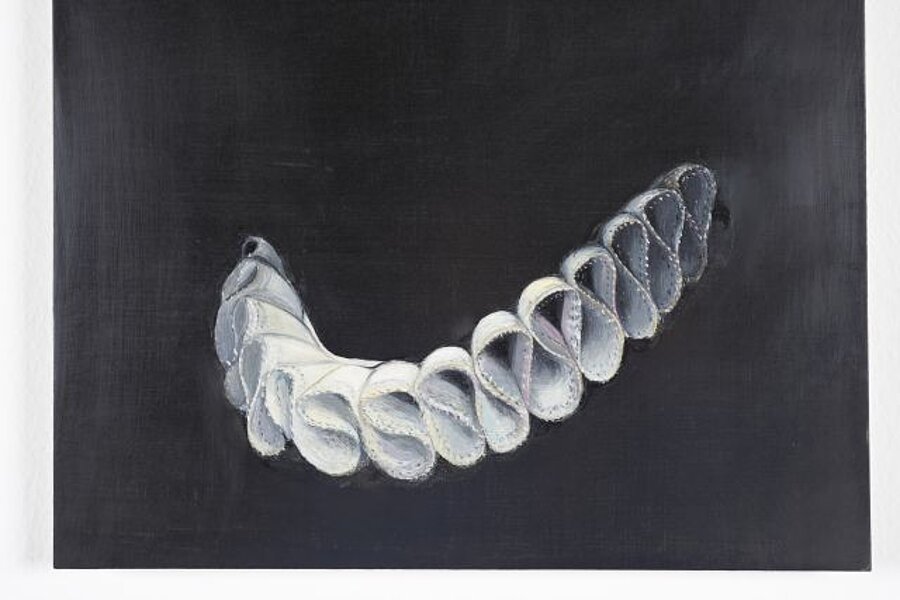
Quaytman, R.H.
Voyelle, Chapter 26 (Das wilde Denken)
Vowel, Chapter 26 (The Wild Thinking)
2013
| Object description | Oil on wood |
|---|---|
| Object category | sculpture |
| Dimensions |
Objekt:
height: 31,5 cm,
width: 31,5 cm,
depth: 1,9 cm
|
| Year of acquisition | 2013 |
| Inventory number | ÖL-Stg 440/7 |
| Creditline | mumok - Museum moderner Kunst Stiftung Ludwig Wien, Leihgabe der Österreichischen Ludwig-Stiftung |
| Rights reference | Quaytman, R.H. |
| Further information about the person | Quaytman, R.H. [GND] |
| Literature | Morning: Chapter 30 R.H. Quaytman |
Since 2001 R. H. Quaytman has structured the production of paintings through an overarching organizational system referred to as a “book,” within which each grouping of paintings for an exhibition is a “chapter.” If painting is the medium most conducive to accelerated circulation within the art world, Quaytman’s open-ended system of archiving imposes a temporal lag in which each work operates outside of itself, defined by its extended lateral relations rather than its singularity. The choice of literary paradigms of division implicates the collapsing of modes of display and storage beyond the truncated event of exhibition, and as such problematizes the operations of the paintings within the art market. The sale of an individual work, or a chapter, is ostensibly destructive to Quaytman’s authorship in the loss of legibility it implies to its interrelation with past and future chapters. This systemic approach carries into the materiality of the paintings through a number of self-imposed rules and restrictions. Each work is painted on a gessoed plywood panel, in one of seven consistent sizes. These panels have distinctive angled edges, painted representations of which often appear on the surface of the paintings. Each chapter responds to the site of its exhibition, transferring strands of an epistemic investigation into historical, architectural, and personal contexts onto the surface of the panels through silkscreen printing and hand painting of images and abstractions. In Voyelle, Chapter 26, Quaytman adopts the historical figure of Empress Elisabeth of Austria as a generative resource, specifically making use of a photographic image of the aristocrat’s death mask, made after she was assassinated by an anarchist in 1898. Rather than a narrative subject to be read across the paintings, this contextual stimulus is presented as a locality from which each painting departs. While mirroring an aspect of their context, the paintings orchestrate perceptual processes of containment and reflection. Using Op-art patterning, surfaces encrusted with diamond dust, and structural elements that divide or support the vertical plane, the image of Elisabeth is at once occluded by, and printed within, the base material of the painting. Behind these movements lies a genealogical displacement: Quaytman also references a portrait of the Empress’s sixteenth-century ancestor Elisabeth of Austria by the miniaturist François Clouet, and the theorizing of this image by the anthropologist Claude Lévi-Strauss in his proposition that all art be understood as a “small-scale model.” Lévi-Strauss describes Clouet’s rendering of a lace collar as deformed by perspective and shadow, but visually perceived as a complete form, comprehended in relation to the whole “event” and social structure of the picture. The repetition in Voyelle of a lace pattern that is highly detailed, yet serves as a flattening screen across the surface of the rectilinear paintings, speaks to an expanded notion of such inscription into a closed system. Voyelle, Chapter 26 tests the boundaries of this system, as an interlinked problem of the symbolic, the temporal, and the economic, by instigating an overlap between chapters. It includes two works that represent Chapter 27—an as yet unrealized body of work to be exhibited at Instituto Inhotim in Brazil—introducing a Janus-faced “blob” into the itinerary of Chapter 26. Quaytman’s assertion of the ultimate value in the connectivity between past and future further implicates the weakened state of painting in the situation of its isolated exhibition.
© mumok – museum moderner kunst stiftung ludwig wien


